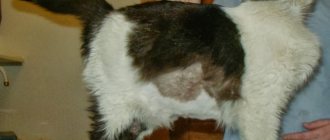Some people believe that a cat’s body is quite primitive compared to a human’s.
In fact, the cat also has a complex endocrine system. Unfortunately, just like people, cats have problems with the endocrine system. Most often, diabetes mellitus, hyperthyroidism (damage to the thyroid gland) or hypercortisolism - an increase in the level of adrenal hormones - develops. They need to be identified in a timely manner, diagnosed and given the correct treatment, otherwise the animal’s quality of life will deteriorate significantly.
Endocrine system of cats and cats
The pituitary gland (Hypophysis) is an endocrine gland associated with the hypothalamic region of the brain, part of the single hypothalamic-pituitary system.
[
The pituitary gland produces important hormones that control many organs and the secretion of hormones from other endocrine glands, including the thyroid, parathyroid, pancreas, adrenal glands, ovaries in females, and testes in males.
Functions:
- The pituitary gland produces growth hormone, which controls growth.
- Prolactin, which stimulates the mammary glands to produce milk.
- Thyroid-stimulating hormone (TSH), which stimulates the thyroid gland.
- Luteinizing hormone (LH), follicle-stimulating hormone (FSH) - these two hormones control heat exchange and ovulation.
- Adrenocorticotropic hormone (ACHT), which stimulates the adrenal glands to produce cortisol and other hormones.
- Melanocyte is a stimulating hormone (MSH) that affects pigment.
- Antidiuretic hormone (ADH), which regulates water metabolism
Because of the role the pituitary gland plays, it is called the master gland. Various diseases can cause problems with the pituitary gland. Symptoms of a particular disease depend on the cause and the part of the pituitary gland that is affected by the disease.
The hypothalamus is responsible for regulating glucose (sugar) and appetite. As the level of glucose in the blood decreases, the cells of the hypothalamus do not receive more of it. The hypothalamus, which is responsible for the feeling of hunger, gives a signal to the body. Unfortunately, animals suffering from a disorder in the hypothalamic-pituitary system have different diseases, but with the same symptoms. An example is diabetes mellitus and pituitary adrenocorticism, where disturbances in blood glucose levels are the main indicator, as well as standard deviations in history (appetite, thirst, apathy, etc.) The hormone insulin, produced by the pancreas, is necessary for glucose to had the ability to penetrate the cells of the body and was used to obtain energy. The pituitary gland produces adrenocorticotropic hormone (ACHT), which stimulates the adrenal glands to produce cortisol and other hormones.
Micro and macro tumors in the pituitary gland can lead to overproduction of adrenocorticotropic hormone (ACTH), which can cause the development of diseases:
- Pituitary hyperadrenocorticism (Cushing's syndrome).
- Panhypopituitarism.
- Acromegaly in cats
The antidiuretic hormone of the pituitary gland (vasopressin), which is responsible for maintaining the correct level of fluid in the body, if the normal functioning of the pituitary gland is disrupted, causes diabetes insipidus in cats.
Diagnosis of pituitary gland diseases is quite laborious and usually requires multiple blood tests, urine tests, diagnostic tests, computed tomography (CT), magnetic resonance imaging (MRI) of the pituitary gland, as well as ultrasound of the organs and glands of the endocrine system.
Reasons for the phenomenon
An increased concentration of sugar is very dangerous because it disrupts metabolism. Therefore, hypoglycemic agents are used to reduce it. It is very important to choose the exact dosage that is suitable for a particular patient.
But sometimes this cannot be done, as a result of which the patient receives more insulin than his body needs. This leads to a sharp decrease in glucose levels and the development of a hypoglycemic state.
Hypoglycemia negatively affects the patient's well-being. To counteract its effects, the body begins to produce increased amounts of protective substances - counter-insular hormones.
Pituitary hyperadrenocorticism disease in cats
Pituitary hyperadrenocorticism (Cushing's syndrome) is rarely observed in cats; in most cases, in affected cats, it is caused by a pituitary tumor, although the cause may be pituitary hyperfunction or adrenal tumors:
- Pituitary microadenoma – about 70%.
- Pituitary macroadenoma – about 30%.
Most often, the disease affects middle-aged and older cats. The disease causes significant weakness and decreased tone in affected cats.
Most common symptoms:
- Thirst.
- Frequent urination.
- Increased appetite.
- Enlarged belly.
- Amyotrophy.
- Hair loss (bilateral symmetrical hair loss).
- Fragile skin syndrome (thin skin that is easily damaged).
- Lethargy, decreased activity.
These signs are common in cats suffering from diabetes, but they do not necessarily indicate excess cortisol.
Diagnosis Diagnosis of diseases is quite labor-intensive and usually requires multiple blood tests, urine tests, diagnostic tests, computed tomography (CT), magnetic resonance imaging (MRI) of the pituitary gland, as well as ultrasound of the organs and glands of the endocrine system.
Treatment Although therapy is quite difficult and the prognosis is difficult, it is worth trying to reduce the destructive effect and alleviate the course of the disease. The best results are provided by hypophysectomy. This is the term used to refer to the surgical removal of the pituitary gland. Although this is technically possible, it is an extremely complex operation that has very high risks and is available in several specialized centers.
Diagnosis of hyperthyroidism
In parallel with hyperthyroidism, a cat may develop kidney disease and diabetes mellitus, since these diseases are typical for older cats and can be triggered by cardiac disorders.
At an appointment with a cat with suspected hyperthyroidism, the doctor may detect exhaustion, poor coat quality, rapid heartbeat, heart murmurs, and an enlarged thyroid gland.
There are no characteristic changes in the general blood test for hyperthyroidism.
In biochemical analysis, liver enzymes, urea, creatinine (azotemia), and phosphates (phosphatemia) may be elevated.
X-rays may reveal cardiac enlargement and, in rare cases, heart failure and pleural effusion.
But the main diagnostic indicator of the disease is an elevated level of thyroxine T4 in the blood, which accounts for 90% of all thyroid hormones (10% is the T3 hormone). The serum concentration of the T4 hormone is determined by special tests.
In cats with early hyperthyroidism, thyroxine levels may initially be within normal limits, so it is important to repeat the measurement after two weeks.
Panhypopituitarism in cats and cats
In this disease, the pituitary gland and nearby organs, including the hypothalamus, are compressed or damaged, which interferes with the functioning of other hormone-producing glands, resulting in various symptoms and diseases. This may be due to injury or infection. They lead to the destruction of pituitary tissue, which causes hormonal deficiency.
One of the causes of panhypopituitarism may be inactive tumors with a long development period. The tumor can become quite large before the affected cat shows signs of illness. The disease is equally likely to develop in cats of any breed, but older cats are most often affected.
Symptoms : A sick animal's behavior changes, they stop responding to people, look depressed, usually try to hide, coordination is impaired, and weight loss is noted. Despite the fact that they are thirsty and constantly consume liquid, they show signs of dehydration. The cat's urination significantly increases and its urination habits are lost - it begins to “go” to the toilet not only in the litter box. In the chronic form of the disease, the growing tumor of the pituitary gland puts pressure on the optic nerve and the animal goes blind.
Treatment Radiation therapy can shrink pituitary tumors and reduce symptoms of the disease, but experience in treating cats with large pituitary tumors is limited. The forecast leaves much to be desired.
Obesity
Obesity is the accumulation of excessively large reserves of fat in natural fat depots.
Usually the result of feeding the cat foods that are too fatty or foods rich in carbohydrates. A predisposing factor is a sedentary lifestyle.
Symptoms
The cat's body takes on a rounded (oval) shape, and skin folds can be distinguished. The cat becomes lazy, moves reluctantly, breathing is heavy with light exertion, the pulse is frequent and small. There are intestinal disorders, manifested in the form of alternating diarrhea and constipation. With a constant sedentary lifestyle, eczema may appear on the skin. In general, the cat's fur is healthy, shiny, and thick.
Treatment
First of all, the cat is prescribed a diet with a predominance of soups in the diet. Long games or walks are required, food is given in small portions 5-6 times a day. Drugs are not used for natural obesity, but for hormonal obesity, the underlying disease is treated.
Acromegaly in cats and kittens
Acromegaly in cats is caused by a tumor of the pituitary gland that interferes with the secretion of essential growth hormone. Occurs most often in cats aged 8 to 14 years. The tumor grows slowly and the disease does not manifest itself for a long time. Since this disease is the cause of diabetes mellitus, it is characterized by the usual symptoms:
- Increased thirst.
- Frequent urination.
- Appetite.
In addition, excessive enlargement of the animal’s paws, chin, skull and other parts of the animal’s body is noticeable. The key sign of acromegaly in cats with uncontrolled diabetes is weight gain. The heart, kidneys, liver and endocrine system organs also increase in size. The level of insulin in the blood is significantly increased. Feline acromegaly is suspected in all diabetic cats with severe insulin resistance.
Diagnosis Symptoms, laboratory blood tests, diagnostic tests, computed tomography (CT), magnetic resonance imaging (MRI) of the pituitary gland.
Treatment Radiation therapy has the best chance of successfully treating the tumor. The disadvantages of the method include delayed tumor reduction and duration of treatment (more than 3 years), as well as the development of hypopituitarism, damage to the cranial and optic nerves, as well as radiation damage to the hypothalamus.
The short-term prognosis for the treatment of individual symptoms of acromegaly using various drugs is favorable for cats. However, if the underlying cause of the disease is not treated, the long-term prognosis is poor. Most cats die from congestive heart failure, chronic renal failure, or conditions related to a growing pituitary tumor.
How can you be sure of the effect?
Before treating any pathology, you need to identify it. The presence of symptoms is only an indirect sign.
In addition, most of the symptoms of Somogyi syndrome resemble hypoglycemia or ordinary fatigue.
Although the hypoglycemic condition is dangerous, it is treated differently from Somogyi syndrome.
And with regard to overwork, completely different measures are required - most often, a person needs rest and relaxation, and not therapy. Therefore, it is necessary to distinguish between these problems in order to use exactly the treatment method that is adequate to the situation.
A diagnosis such as Somogyi syndrome must be confirmed, which is not an easy task. If you focus on a blood test, you can notice irregularities in its formula. But these disorders may indicate both an overdose of insulin (the pathology in question) and its deficiency.
You also need to tell him about all the symptoms detected so that the specialist can form a preliminary opinion. Further examination will be based on it.
There are several methods to confirm the presence of a symptom.
These include:
- Self-diagnosis . Using this method, glucose levels should be measured every 3 hours starting at 21:00. At 2-3 a.m. the body has the lowest need for insulin. The peak effect of the medicine administered in the evening occurs at this time. If the dosage is incorrectly selected, a decrease in glucose concentration will be observed.
- Laboratory research . To confirm the presence of such a disease, a urine test is used. The patient must collect daily and portioned urine, which is tested for the content of ketone bodies and sugar. If hypoglycemia is caused by an excess dose of insulin administered in the evening, then these components will not be detected in every sample.
- Differential diagnosis . Somogyi syndrome has similarities to dawn syndrome. It is also characterized by an increase in glucose levels in the morning. Therefore, it is necessary to distinguish between these two states. Dawn syndrome is characterized by a slow increase in glucose levels starting in the evening. It reaches its maximum in the morning. With the Somogyi effect, a stable sugar level is observed in the evening, followed by a decrease (in the middle of the night) and an increase in the morning.
The similarities between chronic insulin overdose and dawn syndrome mean that you should not increase your dose if you notice high blood sugar levels after waking up.
This is only effective when necessary. And only a specialist can identify the causes of this phenomenon, and you should definitely contact him.
Video tutorial on calculating insulin doses:
Diabetes insipidus in cats
Despite its name, diabetes insipidus has nothing to do with known diabetes, since it has nothing to do with the hormone insulin and sugar metabolism. It is observed very rarely in cats, usually in kittens and young animals.
The antidiuretic hormone of the pituitary gland ADH (vasopressin), which is responsible for maintaining the correct level of fluid in the body, if the normal functioning of the pituitary gland is disrupted, causes diabetes insipidus in cats. Either the pituitary gland does not secrete enough of this hormone (called primary diabetes insipidus) or the kidneys do not respond to the hormone (called nephrogenic diabetes insipidus). A sick animal experiences frequent, profuse urination and equally profuse thirst. Urine has a low specific gravity, transparent, odorless, no protein or sugar (in case of dehydration, urine becomes more concentrated).
Diagnosis If there is no problem with kidney disease and the animal is not dehydrated, tests are performed to further distinguish the etiology of the disease:
- Test – test limiting water consumption.
- Test response to treatment of diuresis with the hormone ADH (vasopressin).
Treatment Frequent urination can be controlled with a medication (desmopressin acetate), which acts similar to the hormone ADH. Treatment is usually lifelong. Water consumption should not be limited.
What to do?
The Somogyi effect is not a disease. This is a reaction of the body caused by improper therapy for diabetes. Therefore, when it is detected, they do not talk about treatment, but about adjusting insulin doses.
The doctor should study all indicators and reduce the dose of incoming medications. A reduction of 10-20% is usually practiced. You also need to change the regimen for administering insulin-containing medications, make dietary recommendations, and increase physical activity. The patient's participation in this process consists of following the instructions and constantly monitoring changes.
- Diet therapy. The patient's body should receive only the amount of carbohydrates that is necessary to maintain life. You should not overuse products containing high amounts of these compounds.
- Changing your medication use schedule. Insulin-containing drugs are administered before meals. Thanks to this, you can evaluate the body’s reaction to their intake. In addition, after eating, the glucose content increases, so the action of insulin will be justified.
- Physical activity. If the patient has avoided physical activity, he is recommended to play sports. This will help increase glucose consumption. Patients with Somogyi syndrome should do exercises every day.
Prevention of hyperthyroidism
Veterinary diet Hills Prescription Diet Feline Y/D Thyroid Health (Hills Prescription Diet Feline Why/D Thyroid Health) is a diet with limited iodine content. Thanks to its special composition, it restores the functioning of the thyroid gland, supports the functioning of the kidneys, bladder, heart, and improves the quality of the coat.
Gag Hyperthyroidism in cats is not exotic at all. This is a fairly common endocrine disease in older cats. The trouble is that it is poorly diagnosed - not every doctor will suspect hyperthyroidism, and not every clinic has tests for the content of thyroxine in the blood serum. And often, when dealing with the symptom of “weight loss with excellent appetite,” you can get advice to deworm your pet. No, deworming is certainly necessary, but there is also hyperthyroidism. It's good that now we know about him!











